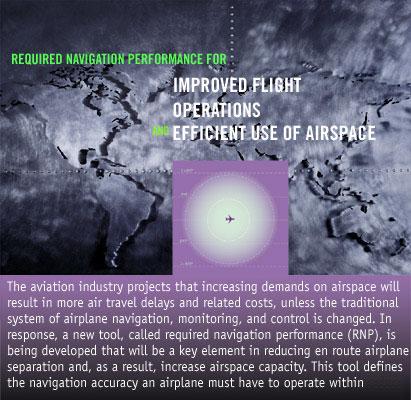Published: October 2000
|
|
Required navigation performance (RNP) extends the capabilities of modern airplane navigation systems by providing real-time estimates of navigation uncertainty, assurance of performance through its containment concepts, and features that ensure the repeatability and predictability of airplane navigation. This precise characterisation of airplane performance is key to designing more efficient airspace routes and procedures.
Before introducing RNP operations into their fleets, operators should understand the following:
- RNP as initially conceived by the International Civil Aviation Organisation (ICAO).
- Industry expansion of ICAO RNP.
- RNP capabilities on Boeing airplanes.
- Assessment of RNP capabilities.
- Operational approvals.
1. RNP AS INITIALLY CONCEIVED BY THE INTERNATIONAL CIVIL AVIATION ORGANIZATION
In 1983, the ICAO formed the Future Air Navigation System (FANS) Committee to develop a broad strategy that included new methods for airplane communication, navigation, and surveillance, and air traffic management (CNS/ATM) (see "Operator Benefits of FANS" in Aero no. 2, April 1998). The navigation element of CNS/ATM centres on the concept of RNP. RNP provides for the specification of airspace based on demonstrated levels of navigation performance and certain functional capabilities, rather than a required set of navigation sensors or equipment. Area navigation (RNAV) functionality is a key element of the RNP concept. (Area navigation systems define waypoints by latitude and longitude coordinates and allow for navigation on any desired flight path rather than one defined by ground-based radio beacons. See "Traditional and Area Navigation.")
ICAO defined RNP as "a statement of the navigation performance accuracy necessary for operation within a defined airspace." This navigation performance accuracy is quantified with two values: a distance in nautical miles (known as the RNP type) and a probability level. For example, an airplane is qualified to operate on an RNP 10 airway if it has demonstrated that the capability and performance of the airplane navigation system will result in the airplane's being within 10 nm of the indicated position on the navigation system at least 95 percent of the flying time (figure 1).

The most powerful feature of the ICAO RNP concept is the specification of a minimum performance requirement without equipment mandates. This is a major improvement over the previous method of deriving airspace design based on traditional discrete navigation systems or on a broad population of airplane navigation systems with widely varying performance. However, other factors besides navigation performance (such as intervention capability, traffic density, and route structure) must be considered in determining the route separation reduction possible with ICAO RNP (figure 2).

2. INDUSTRY EXPANSION OF ICAO RNP
While the ICAO definition of RNP adequately specified 95 percent accuracy performance, it did not quantify other common navigation parameters normally used by industry during equipment design and certification. It also lacked a way to statistically specify potential rare excursions from the desired path. Two aviation standards organisations—the U.S. Radio Technical Commission for Aeronautics (RTCA) and the European Organisation for Civil Aviation Equipment (EUROCAE)—expanded the definition of RNP to include a new lateral containment limit and minimum navigation system capabilities. These additional requirements are documented in the "Minimum Aviation System Performance Standards (MASPS): Required Navigation Performance for Area Navigation," issued by the RTCA.
 Lateral containment limit.
Lateral containment limit.
The new containment limit specifies an additional requirement on navigation system uncertainty beyond the ICAO concept of 95 percent accuracy performance. The lateral (cross-track) dimension of this containment limit is twice the size of the RNP value and centred on the airplane's defined path (figure 3). The navigation system must ensure that the airplane remain within this containment region 99.999 percent of the flight time. This outer linear containment region will be used to assess the safe separation of airplanes and obstacle clearance when developing routes, areas, and procedures.
Minimum navigation system capabilities.
In addition to specifying requirements for continuity and availability of required positioning accuracy, the MASPS specified capabilities to ensure consistency of flight paths and operations across the fleet. For example, the types of flight plan legs that could make up RNP route segments were limited and standardised to ensure that all similarly equipped airplanes fly consistent and repeatable paths over the ground for a given airway or procedure. Also specified in the MASPS was a real-time display of the estimated navigation system accuracy (called "estimated position uncertainty" [EPU] or "actual navigation performance" [ANP] on Boeing commercial airplanes). With an explicit display of EPU/ANP, the flight crew can monitor trends while the navigation system automatically checks current performance against required performance (i.e., the RNP necessary for the operation). The system alerts the flight crew when performance is inadequate for the current operation.
This industry-expanded specification of RNP is called RNP RNAV to differentiate it from the incomplete specification of RNP defined by ICAO. RNP RNAV will be an aid in both separation and collision risk assessments for proposed routes and procedures. This will reduce route separation and improve obstacle clearance limits beyond those provided by ICAO RNP (figure 4). Benefits include increased airspace capacity and efficiency, lower landing minimums, and reduced workload, all of which contribute to improved safety margins.
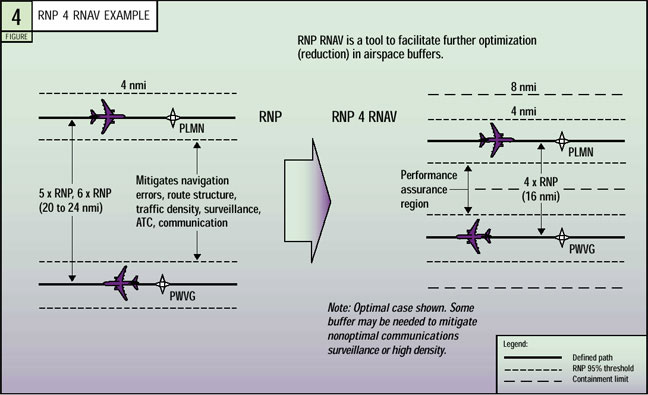
3. RNP CAPABILITIES ON BOEING AIRPLANES
RNP RNAV functionality is available on all Boeing commercial airplanes in production and can be retrofitted on Boeing models delivered without RNP capability.
The MASPS established all significant aspects of navigation system performance, assurance, capability, and functionality that must be considered for RNP-based operations. Because many current systems will not meet every MASPS requirement, any system deviations from the MASPS can be mitigated through limitations or operational procedures. This will allow as many airplanes as possible to be qualified during the transition to RNP operations. The Boeing RNP RNAV designs have addressed all the key functional and performance requirements of the RNP MASPS. Further MASPS-compliant changes to Boeing designs most likely will be warranted by operations and the evolution of RNP. Questions concerning MASPS compliance for specific models should be directed to Boeing Field Service representatives.
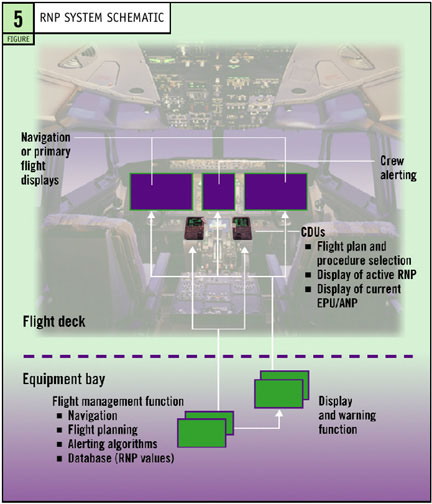 Boeing RNP functionality includes flight crew interface through a flight management control display unit (CDU) and the airplane crew alerting system. Navigation, flight planning, and alerting algorithms are contained in the airplane flight management function (figure 5).
Boeing RNP functionality includes flight crew interface through a flight management control display unit (CDU) and the airplane crew alerting system. Navigation, flight planning, and alerting algorithms are contained in the airplane flight management function (figure 5).
The CDU is used for flight plan and procedure selection and to display the RNP for the active route segment and the current navigation performance (or ANP). RNP values can be stored in the database for route segments, manually entered by the flight crew, or selected automatically, depending on the flight phase (figure 6).
Annunciation to the flight crew occurs when the ANP exceeds RNP. On airplanes with crew alerting systems (such as the 717, 747-400, 757, 767, 777, and MD-90), a text message similar to UNABLE RNP is displayed in the appropriate area on the crew alerting message display. Other airplanes (such as the 737 and MD-80) display the message on the CDU, the navigation display, the primary flight display, or a combination of these.
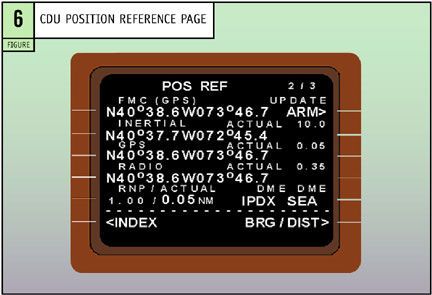
4. ASSESSMENT OF RNP CAPABILITIES
Materials and references are available to help operators assess the capabilities of Boeing RNP-equipped airplanes and to obtain regulatory approval to conduct RNP operations. The materials and references include the Airplane Flight Manual (AFM) for each airplane, RNP capability documents, a Boeing document for an industry RNP RNAV workshop, a U.S. Federal Aviation Administration (FAA) RNP web site, and software for personal computers.
Airplane Flight Manual.
The AFM is an information source on equipment certification and limitations approved by the FAA and other regulatory authorities. The AFMs for Boeing airplanes certified for RNP RNAV capability contain some or all of the following information:
-
The minimum demonstrated RNP as a function of the lateral flight control mode. This is the smallest RNP value for which the airplane equipment has been certified to operate at a given lateral control mode (e.g., the flight management system [FMS] lateral navigation with autopilot engaged). Values are provided for an active and inactive global positioning system (GPS). This accommodates airplanes that do not use GPS to navigate and periods when satellite signals may not be available to support operations that require GPS to achieve the desired level of RNP. The AFM notes that an RNP flight operation may be subject to signal availability for both GPS and ground-based navigation aids (see the following section on RNP capability documents).
- The minimum equipment required for RNP navigation.
- RNP values that provide airplane navigation performance equivalent to traditional airplane navigation while conducting operations on current approaches that do not require RNP.
- Explicit statements of compliance with regional RNP-related criteria.
RNP capability documents.
These documents explain Boeing RNP implementation as it relates to equipment certification and RNP operational approvals. They include the following (see table 1):
-
A detailed technical description of ANP, including ANP values that can be expected, and when GPS and GPS coverage predictions may be required for an RNP operation.
- Automatic default RNP values and phase-of-flight logic.
- The concepts of required availability of navigation equipment and navigation signals.
- Flight crew interface, including descriptions of RNP-related CDU page displays and scratchpad text messages, flight crew alerts, and navigation displays related to RNP and GPS navigation.
- The availability of different levels of RNP to satisfy primary and supplemental means of navigation.
- Example applications of RNP for en route and terminal route separation and approach area obstacle clearance.
- Discussion of the equivalency of RNP operations and values to existing charted instrument approach procedures approved for non-RNP RNAV-equipped Boeing airplanes.
- Derivation of the demonstrated minimum RNP values listed in the AFM.

Boeing document for an industry RNP RNAV workshop.
A Boeing web site offers access to the following document on RNP and RNAV operations: "FMS RNAV Workshop—General Information on the Functional and Technical Aspects of Required Navigation Performance (RNP) Area Navigation (RNAV) and Applications" (http://www.boeing.com/commercial/caft/reference/documents/RNP.pdf).
FAA RNP web site.
This site presents a variety of information on existing programs to implement RNP (http://www.faa.gov/ats/ato/rnp.htm).
Flight Procedures Standards Branch web site.
The FAA's vision for implementing RNP in the U.S. national airspace is explained on this site (http://www.mmac.jccbi.gov/afs/afs420/OutReach/index.htm).
[Ed: Link no longer valid]
European Organisation for the Safety of Air Navigation (EUROCONTROL) web site.
Of special interest are the Terminal Area RNAV Applications subgroup and the "EUROCONTROL Standard Document for Area Navigation Equipment—Operational Requirements and Functional Requirements." This document is available through the document library on the web site (http://www.ecacnav.com/default.htm).
Software for personal computers.
Several software applications are available from vendors of GPS receivers that can help operators determine whether adequate GPS signal coverage is available for an RNP flight operation. Contact the vendors for copies.
5. OPERATIONAL APPROVALS
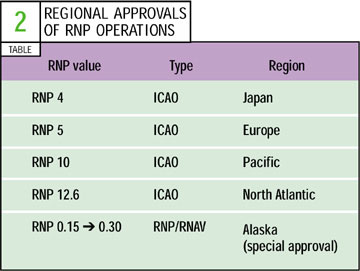 RNP operations.
RNP operations.
RNP operations gradually are being introduced around the world on a regional or case-by-case basis. Operations requiring RNP capabilities are noted on the applicable airways and regional airspace documentation or procedure charts. These operations have varying RNP functional and performance requirements. Some are more consistent with ICAO RNP, which allows RNAV-equipped, non-RNP airplanes to be qualified to a level of RNP equivalency based on originally installed equipment, demonstrated performance, or both. Other operations require full RNP RNAV functionality. Table 2 lists some initial regional approvals of RNP operations.
RNP RNAV operations.
In most cases, RNP RNAV operations are initiated by a few operators who have determined that their existing airplane RNP RNAV capabilities can provide operating efficiencies. Achieving RNP RNAV operational approval requires operators to closely coordinate with all interested parties, including airspace providers, regulatory agencies, and flight crew representatives. This ensures that decisions on route or procedure configuration, adjacent route separation, and obstruction clearance take into account important factors such as the availability and quality of surveillance, communications, the navigation infrastructure, traffic density, and air traffic control procedures. In the future, when routes and procedures are developed to RNP criteria, the regulatory authority responsible for an airline's operation will verify that RNP-capable airplanes meet the RNP requirements for the operation.
SummaryRNP allows airspace to be specified according to demonstrated airplane navigation performance and certain airplane functional capabilities, rather than a required set of navigation sensors or equipment. RNAV functionality is a key element of the RNP concept. Knowing in advance that airplanes can perform RNAV functions and achieve a predetermined level of navigation performance allows for more optimal design of airspace and procedures and eliminates the need to mandate specific equipment and systems for airspace operations. RNP functionality exists on all Boeing production airplanes and is available for retrofit on earlier models. Operators who choose to implement RNP can benefit from improved safety of flight in their operations and access to new, more efficient flight operations procedures. |
FOR DETAILS ON RNP RETROFITS, CONTACT BOEING AIRPLANE SERVICES.
Phone: 425-865-7950 Fax: 425-865-7896
E-mail: airplaneservices@boeing.com
Address: P.O. Box 3707 MC 7R-72 Seattle, WA 98124-2207 USA
FOR ASSISTANCE WITH RNP PROCEDURES, CONTACT BOEING AIR TRAFFIC MANAGEMENT SERVICES.
Phone: 206-662-8500 Fax: 206-662-8688
E-mail: david.l.allen@boeing.com
Address: P.O. Box 3707 MC 29-09 Seattle, WA 98124-2207 USA Attention: David L. Allen
JEFF AIMAR
ASSOCIATE TECHNICAL FELLOW
AIR TRAFFIC MANAGEMENT SERVICES
BOEING COMMERCIAL AIRPLANES GROUP
| Top of page | Boeing Home | Boeing Commercial | Contact Aero |
Aero Copyright © 2003 The Boeing Company. All rights reserved.
